Buschow K.H.J. (Ed.) Concise Encyclopedia of Magnetic and Superconducting Materials
Подождите немного. Документ загружается.


Magnetism: Applications of Synchrotron
Radiation
Magnetism in solids covers a large variety of prop-
erties ranging from bulk characteristics of permanent
magnets or recording and storage devices to funda-
mental microscopic phenomena in quantum systems.
The measurement of bulk magnetic properties (such
as susceptibility, magnetization, and anisotropy) rep-
resents the first and necessary step to determine the
magnetic state of a material. However, a proper un-
derstanding of the magnetic properties requires a
knowledge of the electronic ground state. Magnetic
moments originate from unpaired electrons; the elec-
tron spins interact through various exchange cou-
plings to form ordered spin structures, while the
electron orbital moments contribute to the total mag-
netization via spin–orbit couplings.
Therefore, magnetism depends on electronic prop-
erties at the atomic level and/or at the electron
band level. The observation of transport properties
provides information on the electronic properties.
Nevertheless, the understanding of magnetism neces-
sitates the determination of the electronic states that
carry the magnetization, and the knowledge of the
magnetic order and magnetic interactions at a mi-
croscopic level. Local probes (NMR, Mo
¨
ssbauer
spectroscopy, mSR) can be exploited to obtain some
insight as to the nature of the magnetization. Scat-
tering techniques provide microscopic details about
the magnetic sites, the arrangement, and the dynam-
ics of the ordered magnetic moments. (For NMR and
Mo
¨
ssbauer spectroscopy see Cahn and Lifshin
(1993); for mSR see Muon Spin Rotation (mSR):
Applications in Magnetism.)
Scattering experiments convey information on spa-
tial Fourier transforms of correlation functions. Dif-
fraction experiments reveal static correlations,
including short- and long-range ordered structures,
while inelastic scattering experiments are used to ob-
serve time-dependent correlations, i.e., fluctuations,
normal modes, and collective or localized excitations.
The energy range spanned by the excitations is related
to the size of the interactions, which are roughly de-
fined by the ordering temperature in the range 1–300 K
(0.1–30 meV energy range). However, the energy scales
associated with electronic bands are in the electron
volt range. An ideally suited scattering probe should
cover all these energies. Traditionally neutron scatter-
ing is the probe of choice. However, in the past optical
effects in the visible range (Faraday and magneto-Kerr
effects) have confirmed the existence of interactions
between photon polarization and magnetization: the
polarization of light is rotated upon transmission
through, or reflection from, a magnetized medium.
Similar phenomena (dichroic signals) are ob-
served in soft and hard x-ray absorption experiments,
when the photon energy is adjusted near an x-ray
absorption edge of a magnetic atom. Reciprocally,
x-ray scattering experiments show large resonant
enhancements of the scattered intensities yielding
count rates in the range 10
4
–10
6
photons s
1
. These
resonant effects in x-ray scattering are superimposed
on nonresonant effects, which are much weaker. The
developments in the use of x rays rely on tunable
photon sources and the scientific interest in the ap-
plications of x-ray methods to probe magnetism has
increased since the development of modern synchro-
tron radiation sources.
1. Scattering Probes: Synchrotron X Rays vs.
Neutrons
X-ray and neutron scattering techniques are analo-
gous in many ways but their strengths are comple-
mentary. Neutrons are considered as the probe of
choice for the study of magnetism by means of scat-
tering methods for two reasons (Squires 1978): (a)
neutrons possess a spin and the associated neutron
magnetic moments couple significantly to the magnet-
ization in materials; and (b) the rather low kinetic
energy of neutrons (3–100 meV at reactor sources)
allows easy inelastic experiments adapted to magnetic
properties. A large fraction of the understanding of
microscopic magnetism (magnetic structures, magnetic
excitations) comes from neutron scattering results.
However, neutron beams have low flux and neutron
scattering experiments require large scattering vol-
umes. Furthermore, neutrons as a magnetic probe are
sensitive to the total magnetization and do not distin-
guish readily contributions from different elements,
different electronic shells, or spin vs. orbital momen-
tum. Neutrons cannot probe electronic properties.
X rays, when applied to magnetism, suffer from a
serious drawback: the nonresonant coupling between
the electromagnetic field associated with the photons
and the spin and orbital momentum distributions is
weak. This interaction was evidenced experimentally
in the early 1970s (de Bergevin and Brunel 1972) but
was considered as a curiosity until more powerful
x-ray sources became available. The reason behind
the use of x-ray methods for the study of magnetism
arises from the unique properties of x-ray synchro-
tron radiation: (i) a high brilliance, which gives a
large particle flux over an extremely small beam size;
(ii) a wide range of photon energy tunability; and
(iii) a well-defined polarization state of the emitted
radiation. Modern synchrotron sources available
worldwide can accommodate different undulators as
radiation sources which produce x rays with energy
ranging from a few hundred electron volts to
30–40 keV. On the high-energy side, multipole wig-
glers produce photons up to 300 keV. High brilliances
up to 10
20
photons s
1
mm
2
mrad
2
per 0.1% band-
width have been reached at the European Synchro-
tron Radiation Facility (ESRF) in Grenoble, France.
740
Magnetism: Applications of Synchrotron Radiation

The x-ray polarization is readily tunable, with an al-
most perfect degree of linear polarization. Special in-
sertion devices are designed to produce elliptically or
circularly polarized radiation.
The high photon flux available at synchrotrons
compensates for the weakness of the nonresonant
magnetic x-ray scattering amplitude, and the easily
tuned photon energy has boosted resonant studies.
Magnetic resonant x-ray scattering combined with
the high brilliance of synchrotron x-ray beams makes
it possible to investigate small scattering volumes
(microcrystals, thin films, surfaces) or weak magnetic
moments (down to 0.01m
B
). The resonant process is
element selective and electronic shell sensitive, allow-
ing detailed studies of the origin of magnetic mo-
ments. The time structure of the synchrotron
radiation (x-ray bunches at 357kHz at the ESRF)
can be exploited to study the dynamics of magnetic
processes in real time down to the nanosecond scale
(Bonfim et al. 1998).
When used together, x-ray and neutron methods
offer a broad range of capabilities and the choice of
the technique depends on the details of the problem
to be solved. Neutrons are essential in determining
magnetic structures (magnetic powder diffraction)
and in characterizing magnetic excitations (the ob-
servation of magnetic excitations will not be dis-
cussed). However, synchrotron x rays provide more
information about the electronic character of mag-
netism (separation of orbital momentum and spin,
sensitivity to the electronic shell and to the chemical
species). Owing to the properties of synchrotron
x-ray beams (brilliance, collimation, time structure),
x rays are preferred over neutrons for the investigation
of minute samples (surfaces, thin films), time-resolved
studies, and high Q-resolution experiments. However,
in the case of scattering experiments, the high colli-
mation of synchrotron beams must be matched by the
crystalline quality of the materials. As a consequence,
only good-quality crystals can be studied; for powder
samples, ab initio magnetic structure determinations
are performed using neutron diffraction.
In the following, the basic character of the inter-
actions of x rays with magnetism is outlined, includ-
ing a description of the scattering amplitudes (elastic
Bragg scattering or diffraction and Compton scatter-
ing) and the spin-dependent x-ray absorption meth-
ods (magnetic dichroism). Potential applications are
indicated and comparison with neutron methods is
made when appropriate.
2. Scattering Cross-sections
The x-ray or neutron intensity diffracted by an as-
sembly of atoms is written in terms of an elastic scat-
tering cross-section:
ds
dO
¼
X
n
e
iQR
n
f
n
ðk
i
; k
f
; _oÞ
2
ð1Þ
where _o is the x-ray energy, k
i
and k
f
are the inci-
dent and scattered wave vectors of the photons, Q is
the probe momentum transfer (Q ¼k
i
k
f
), and f
n
represents the scattering amplitude from the nth at-
om. Two limiting regimes are distinguished for x rays:
the resonant scattering (when the incident photon is
close to an absorption edge of a magnetic species in
the material) and the nonresonant scattering (when
the photon energy is far from any absorption edge). It
is convenient to separate the different contributions:
f
n
ðk
i
; k
f
; _oÞ¼f
charge
n
ðQÞþf
nonres
n
ðk
i
; k
f
Þ
þ f
res
n
ðk
i
; k
f
; _oÞð2Þ
where f
charge
n
denotes the familiar Thomson scattering
from charge distribution, f
nonres
n
is the nonresonant
magnetic scattering, and all contributions to the res-
onant scattering are included in f
res
n
.
The processes discussed here correspond to coher-
ent elastic scattering; there are also inelastic processes,
known as Compton scattering, during which photons
exchange energy with the scattering system. In such a
case, the scattering is incoherent and photons are
scattered by individual electrons.
The absorption cross-section, which is measured in
spin-dependent absorption experiments, is related to
the scattering amplitude in Eqn. (2) through the op-
tical theorem:
s
a
¼ 2lIm½f
n
ðk
i
; k
f
; _oÞ ð3Þ
These different cases for x rays are discussed in the
following sections. Neutrons are used in the scatter-
ing mode only. Furthermore, only the elastic case is
considered here.
3. Nonresonant Regime
The nonresonant x-ray regime encompasses coherent
Bragg scattering (diffraction) and the Compton in-
elastic process.
3.1 Nonresonant X-ray Magnetic Bragg Scattering
The nonresonant x-ray magnetic scattering amplitude
is written as (Blume and Gibbs 1988):
f
nonres
n
ðk
i
; k
f
Þ¼ir
0
_o
mc
2
1
2
L
n
ðQÞAðe
i
; e
f
ÞþS
n
ðQÞBðe
i
; e
f
Þ
ð4Þ
where L
n
(Q) and S
n
(Q) are the Fourier transforms of
the orbital momentum and spin magnetization den-
sities (form factors) at the nth site, r
0
is the classical
radius of the electron (2.8 10
15
m), a standard unit
741
Magnetism: Applications of Synchrotron Radiation

in atomic scattering processes, and mc
2
is the rest
energy of the electron (511 keV). The vector quanti-
ties A(e
i
, e
f
) and B(e
i
, e
f
) depend on the polarization
vectors e
i
and e
f
of the incident and scattered wave
vectors, respectively; they are not identical and have
distinct Q dependencies.
A compact expression has been obtained:
f
nonres
n
ðk
i
; k
f
Þ¼ir
0
ð
l
e
QÞ
cos yS
2
sin y½cos yðS
1
þ L
1
Þ
sin yS
3
sin y½cos yðS
1
þ L
1
Þ cosy½S
2
þ 2sin
2
yL
2
M
þsin yS
3
0
B
B
B
B
@
1
C
C
C
C
A
ð5Þ
where y istheBraggangleand
l
c
is the Compton
wavelength ( ¼3.81 10
3
A
˚
). L(Q)andS(Q) are given
by their components (a ¼1,2,3) in the coordinate
system u
1
, u
2
, u
3
, where u
1
is directed along k
i
þk
f
, u
2
is perpendicular to the scattering plane and parallel to
k
i
k
f
, and u
3
is along Q. The matrix form for
f
nonres
n
ðk
i
; k
f
Þ is used to describe the polarization de-
pendence. The basis vectors for the polarization e
i
and e
f
correspond to a linear polarization either per-
pendicular (s) or parallel (p) to the scattering plane.
From Eqn. (5) it can be seen that the contributions
from L and S to the total magnetization M ¼L þS
can be obtained separately from magnetic x-ray scat-
tering data. Such a separation is not readily possible
in neutron diffraction experiments because neutrons
are sensitive to the total moment. It should be noted
that f
nonres
n
ðk
i
; k
f
Þ is not a spherical tensor formed
with (e
i
, e
f
) in contrast to the usual Thomson scat-
tering:
f
charge
n
ðQÞ¼r
0
rðQÞe
i
e
f
ð6Þ
This difference helps in separating the Thomson
charge from purely magnetic x-ray scattering. Com-
parison of Eqns. (5) and (6) provides a rough estimate
for the relative amplitude of magnetic scattering and
charge scattering. If all form factors and geometrical
factors in A(e
i
, e
f
) and B(e
i
, e
f
) are set to unity, then:
f
nonres
n
f
charge
n
2
Eð
l
c
QÞ
2
m
2
N
m
N
2
ð7Þ
where m is the electron average magnetic moment
(expressed in m
B
)andN
m
is the number of magnetic
electrons compared to the total number of electrons,
N,atsiten. For conventional diffraction cases,
7Q7¼1–6 A
˚
1
, N
m
/N ¼0.1, and the ratio of intensi-
ties is around 10
6
. In practice, this ratio is even
smaller because of the geometrical factors in Eqn. (5).
This explains why the advent of bright third-genera-
tion synchrotron sources has boosted the development
of x-ray techniques by alleviating the consequences of
the inherent weakness of nonresonant x-ray magnetic
scattering amplitudes.
The neutron counterpart of Eqn. (4) is written as:
f
neutron
ðQÞ¼f
nuc
ðQÞþr
0
g
2
p ðQ ½Q MðQÞÞ ð8Þ
where p is the neutron beam polarization, g is the
neutron gyromagnetic factor ( ¼1.91), M(Q) is the
Fourier transform of the total magnetization, and
f
nuc
(Q) is the scattering amplitude from the nuclei in
the solid. Note that neutrons couple to the Fourier
transform M(Q) ¼L(Q) þ2S(Q) of the total magnet-
ization. The L/S separation can only be achieved by
modeling the Q dependence of the two contributions,
L(Q) and S(Q).
In the case of ferro- or ferrimagnetic materials, the
magnetic Bragg peaks occur at the same positions in
reciprocal space as the more intense crystal structure
peaks. Interferences between the magnetic scattering
amplitude and the scattering amplitude from the
crystal structure allow the observation of the mag-
netic signal. A practical way to extract the magnetic
information is to reverse the magnetization direction
by applying an alternating magnetic field (reversing
the interference term) and to collect the intensity as a
function of field orientation; this gives the so-called
flipping ratio, R, defined as:
R ¼
IðmÞI ðkÞ
IðmÞþI ðkÞ
In the x-ray case, because f
nonres
n
ðk
i
; k
f
Þ and f
charge
n
ðQÞ
are out of phase by p/2 (Eqns. (4) and (6)), interfer-
ence only occurs in the case of circular polarization
(the e
i
and e
f
vectors are complex) or if the crystal
structure factor is imaginary (large absorption and/or
noncentrosymmetric structure). In the neutron case, a
finite neutron polarization is required to have inter-
ference effects. In this case, R is obtained by flipping
the polarization of the neutron beam:
R ¼
1 þ 2pAðQÞþAðQÞ
2
1 2pAðQÞþAðQÞ
2
where p is the neutron polarization and
AðQÞ¼
MðQÞ
f
nuc
ðQÞ
Owing to the larger neutron magnetic scattering
amplitude, weak magnetic moments M(Q) can be ex-
tracted (i.e., field-induced magnetization in paramag-
nets) provided f
nuc
(Q) and p are known accurately.
Usually, neutrons can detect magnetic moments down
to 0.05m
B
. However, x rays have an advantage over
neutrons when the sample under investigation is very
small, because of the high brilliance of synchrotron
sources. Ferromagnetic thin films or multilayers and
742
Magnetism: Applications of Synchrotron Radiation
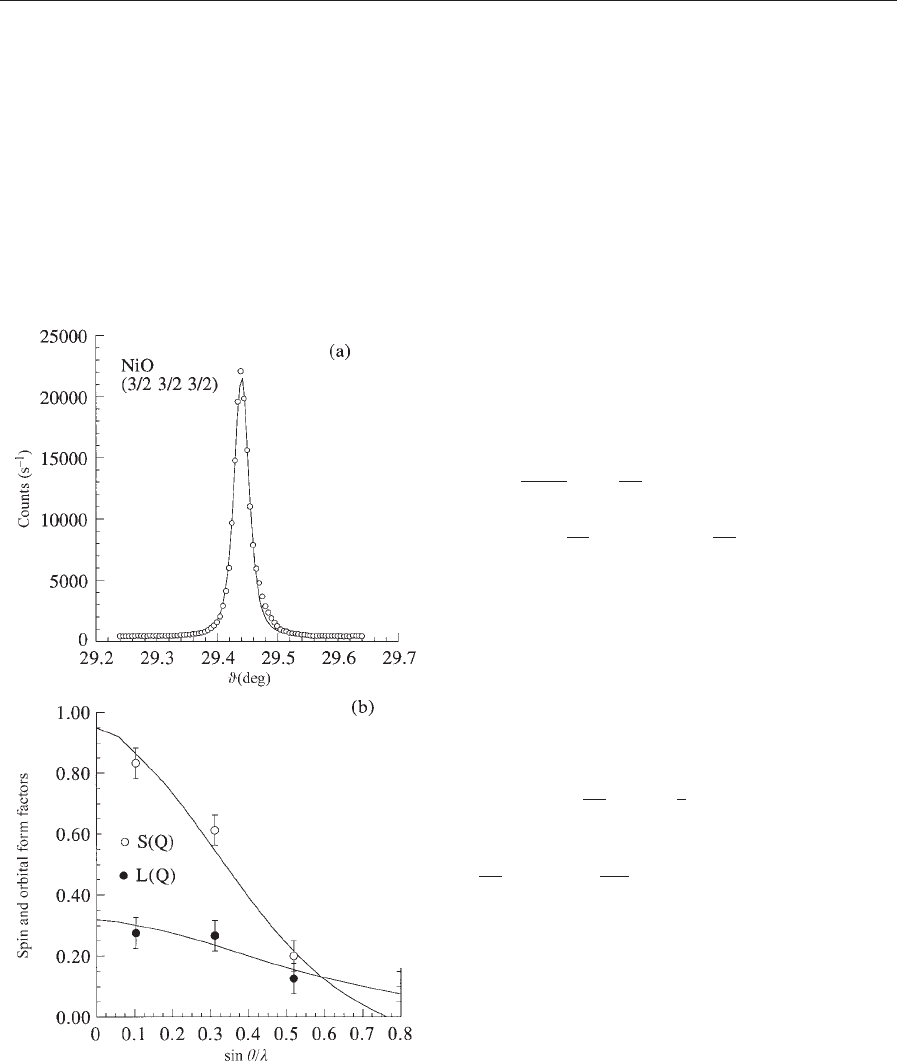
interfacial magnetism are routinely studied by means
of magnetic x-ray scattering.
In the case of antiferromagnetic systems, the mag-
netic diffraction peaks occur at positions in reciprocal
space that are forbidden for crystal structure reflec-
tions, and the limiting factor for detection is the
scattered intensity. Figure 1 shows examples of data
obtained from third-generation synchrotron sources.
Figure 1(a) gives an indication of the scattered in-
tensities available at modern synchrotron sources.
Also shown in Fig. 1 are the magnetic form factors
L(Q) and S(Q) that have been determined independ-
ently by exploiting the polarization dependence of the
scattering amplitude in Eqn. (5) (Fernandez et al.
1998). It is worth noting that at the high-energy limit
for Bragg scattering (low Bragg angle y), the x-ray
magnetic scattering is dominated by the spin contri-
bution, whereas the orbital momentum part becomes
negligible (Eqn. (5)).
An important aspect of diffraction experiments is
the Q-resolution. Owing to the highly collimated
beams, synchrotron x-ray experiments allow high
Q-resolution conditions which cannot be reached
with neutron scattering experiments. This is particu-
larly useful in detecting minute changes in the lattice
parameters occurring at magnetic phase transitions
due to magnetostriction effects.
3.2 Magnetic Compton Scattering
Inelastic Compton scattering is an incoherent process
where the scattering cross-section can be written as
(Lovesey and Collins 1996):
ds
dOdo
¼ N
m
_k
i
ds
dO
charge
Jðp
z
Þþ
ds
dO
mag
J
spin
ðp
z
Þ
"#
ð9aÞ
where J(p
z
) is the usual Compton profile (a two-
dimensional average perpendicular to the scattering
vector of the momentum density). The magnetic
Compton profile given by J
spin
(p
z
) ¼
1/2
[J
m
(p
z
)
J
k
(p
z
)] is the difference between the profiles of
spin-up electrons and spin-down electrons. The dif-
ferential cross-sections contain geometrical and po-
larization factors:
ds
dO
Charge
¼
1
2
r
2
0
ð1 þ cos
2
yÞ
ds
dO
spin
¼r
2
0
p
c
_o
mc
2
ð1 cos yÞð
#
k
i
cos y þ
#
k
f
Þz ð9bÞ
where z is the unit vector parallel the magnetic axis,
#
k
i
and
#
k
f
are unit vectors along k
i
and k
f
; and p
c
is the
degree of circular polarization of the incident x-ray
beam. Similarly to the previous discussions on ferro-
magnets, the magnetic Compton profile is isolated
from the total spectrum by reversing either the mag-
netization direction, z, or the x-ray helicity, p
c
.By
measuring profiles along several directions, it is pos-
sible to reconstruct the three-dimensional spin polar-
ized momentum density and compare it with
theoretical electronic band calculations. Only mag-
netic Compton experiments can supply these exper-
imental confirmations.
Figure 1
Nonresonant magnetic x-ray scattering from NiO.
(a) Angular profile of an antiferromagnetic peak. (b)
Q-dependence of the spin and orbital moment form
factor as extracted from the polarization analysis of
experimental data.
743
Magnetism: Applications of Synchrotron Radiation

4. Resonant Regime
The nonresonant x-ray magnetic scattering amplitude
in Eqn. (5) vanishes in the forward direction at Q ¼0,
leading to the absence of magnetic effects in x-ray
transmission or x-ray reflection measurements. How-
ever, the optical index in the visible region varies with
the magnetization direction relative to the light po-
larization, which is the origin of magneto-optics. In
the hard x-ray region, the optical index is very close
to unity, and similar effects are not observed. Only
near an absorption edge does the x-ray index differ
from unity due to the anomalous part of the scatter-
ing amplitude, and magnetic effects are detected. The
scattering experiments and the absorption methods
can be treated in parallel near resonance. Indeed,
resonant scattering originates from second-order per-
turbation processes which can be pictured as the ab-
sorption of an incident photon, the creation of a
short-lived intermediate state, followed by decay
back to the ground state. In the case of elastic scat-
tering, a photon is elastically scattered during the
decay. These intermediate states correspond to the
promotion of an inner shell electron to a bound or
nearly bound level in an outer shell with a high den-
sity of states, leaving behind a core hole. The same
intermediate levels contribute to the white line in
normal x-ray spectroscopy. The outer electronic
shells are sensitive to the local symmetry of atomic
sites and the scattering amplitude reflects the sym-
metry of the associated wave functions with respect
to the relative orientation of the incident x-ray po-
larization. When the incident photon energy is tuned
to a resonance, the scattering amplitude contains
terms which reflect the local symmetry, possibly lead-
ing to new Bragg peaks which are forbidden away
from resonance (Templeton 1994).
The onset of local magnetic moments is a partic-
ular case of symmetry breaking which induces reso-
nant terms in the x-ray scattering amplitude, f
res
n
,
contributing to the total scattering amplitude in Eqn.
(2) (Blume 1994). The resonance occurs through elec-
tric multipole transitions from a core level into empty
electronic shells. The sensitivity to the magnetization
arises from the difference in transition probabilities
due to the spin polarization of the intermediate states,
the spin–orbit couplings, and the exchange interac-
tions. The strength of the resonance is given by the
multipole electric transition matrix elements and
the spin polarization of the intermediate states. The
strongest transition is the electric dipole (E1 with
Dl ¼1) contribution; the next strongest is given by the
electric quadrupole (E2 with Dl ¼2) contribution, but
the relative weakness of the E2 contribution must be
balanced with the size of the spin polarization of the
associated intermediate states. This is illustrated with
the example of 4f and 5f systems. The f electronic
states which carry the main magnetic moments are
probed directly by E1 transitions at the M
4
and M
5
edges (3d-f). They are also examined by E2 tran-
sitions at the L
2
and L
3
edges (2p-f); but at the same
L
2
and L
3
edges, the d moments, which are polarized
by the f electrons, are probed by E1 transitions (2p-
d). This example demonstrates the versatility and the
electronic selectivity for the study of the origin of
magnetic moments. The resonant process is also
chemical selective, because the resonant energy
changes with the chemical species and valence state.
The resonant scattering amplitude can be expressed
as a series expansion:
f
res
n
ðk
i
; k
f
; _oÞ¼f
res
nE1
ðk
i
; k
f
; _oÞ
þf
res
nE2
ðk
i
; k
f
; _oÞþ? ð10aÞ
where f
res
nEL
ðk
i
; k
f
; _oÞ are contributions from E1 and
E2 transitions (Hannon et al. 1988).
The E1 contribution to the scattering has the form:
f
res
nEI
ðk
i
; k
f
; _oÞ¼F
ð0Þ
1
0
0
cos 2y
iF
ð1Þ
0
z
1
cos y þ z
3
sin y
z
1
cos y þ z
3
sin y
z
2
cos y
þ F
ð2Þ
z
2
2
z
2
ðz
1
sin y þ z
3
cos yÞ
z
2
ðz
1
sin y z
3
cos yÞ
cos
2
yðz
2
1
tan
2
y þ z
2
3
ð10bÞ
where z
i
are components of the moment direction z
in the coordinate system defined above. F
(n)
are res-
onant amplitudes which contain a resonant denom-
inator
1
E
a
E
c
þ _o i
G
2
dipole radial matrix elements /c7r7aS, and spin po-
larization of the intermediate states (only in the case
of F
(1)
and F
(2)
) (Hannon et al. 1988). E
a
, 7aS and E
c
,
7cS are the energies and wave functions of the
ground and intermediate states, respectively, and G is
the inverse lifetime of the intermediate state.
The first term in Eqn. (10b) is independent of z and
does not contribute to the magnetic scattering; it is the
usual anomalous x-ray scattering term which contrib-
utes to white lines in the fluorescence signal. The sec-
ond term is linear in z and contributes to the amplitude
of magnetic Bragg peaks. The third term is quadratic
in z and leads to second-order resonant harmonics.
More complex terms appear in the E2 contribution,
which contains terms up to fourth-order in z produc-
ing third- and fourth-order resonant harmonics.
In order to exploit the resonant enhancement for a
given magnetic species, the photon energy is tuned
to an absorption edge where the core electron is
promoted into the electronic shell that carries the
magnetization via the strong E1 transitions. Examples
744
Magnetism: Applications of Synchrotron Radiation
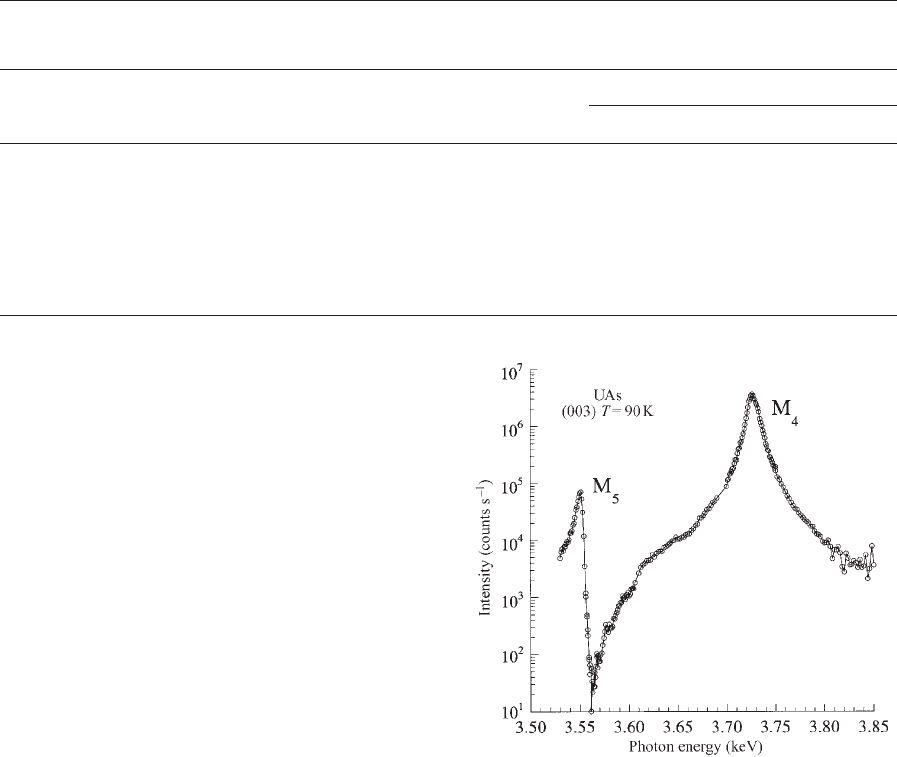
are given in Table 1. Theoretical estimates for the
resonant enhancements predict that the resonant scat-
tering amplitude would reach 10r
0
at the M edges of
actinides and even 100r
0
at the M edges of rare earths,
but would be more modest at the L edges of rare
earths, around 0.1r
0
. A severe limitation arises from
the long wavelengths associated with the strongest
resonances. At wavelengths larger than 5A
˚
, diffraction
experiments are difficult owing to absorption prob-
lems and to the lack of accessible Bragg peaks. In
practice, actinide materials are studied at the L
2,3
and
M
4,5
edges, which allows the study of both the f and d
magnetism.
For rare earth materials, resonant scattering ex-
periments are performed at the L
2,3
edges, where d
electrons are probed. In the soft x-ray range the M
4,5
edges that give access to the f magnetism, allow
measurements of magnetic x-ray reflectivity and spin-
dependent absorption. The 3d transition metals can
be investigated at the L edges, where only reflectivity
measurements or studies of artificial multilayers can
be performed. The resonant process at the K edge
involving p electrons is weak and complex.
Figure 2 shows an example of the resonant en-
hancement as observed in the antiferromagnetic com-
pound UAs. At the M
4
edge of uranium, the resonant
enhancement of the x-ray magnetic scattering ampli-
tude has been measured to be 9r
0
yielding scattered
intensities in the 10
6
counts s
1
range. Such a large
scattering amplitude leads to potential applications,
which complement neutron diffraction results, taking
advantage of the resonant selectivity and of the large
resonant enhancement coupled with the large available
x-ray flux. In short, resonant x-ray scattering makes it
possible to search for weak signals and to disentangle
magnetic properties of different chemical elements or
electronic shells. It should be pointed out that the gain
in scattered intensity at resonance does not make mag-
netic powder diffraction experiments readily feasible
with x rays, because of absorption and fluorescence
effects. Powder neutron diffraction remains the probe
of choice for structure determination.
Weak scattering signals arise either from small
magnetic moments or from small scattering volumes.
There exist systems which possess extremely small
magnetic moments that neutrons cannot ‘‘see’’ unless
a large amount of material is available. Resonant
x rays are perfectly suited to studies of such systems
with constrained dimensions (microcrystals, surfaces,
and interfaces). Magnetic thin films and magnetic
surfaces are investigated by using soft x-ray reflec-
tivity (Kao et al. 1994, Tonnerre et al. 1995) or
by scattering methods in the harder x-ray region
Figure 2
Resonant scattering at the M
4
and M
5
edges of uranium:
resonant enhancement of the antiferromagnetic
diffracted intensity in UAs as a function of the incident
photon energy. The two resonances are clearly seen. The
energy line shape of the intensity corresponds to the sum
of two interfering amplitudes with resonant
denominators.
Table 1
Significant resonances for selected magnetic species.
Resonant energy
Magnetic species Resonance process Energy (keV) Wavelength (A
˚
)
3d transition metal Fe E1 p2d L
2
,L
3
0.71 17.5
E1, E2 s2p, d K 7.1 1.75
5d transition metal Pt E1 p2d L
2
,L
3
11.5–13 1.08–0.95
E1, E2 s2p, d K 78.4 0.16
4f rare earth Gd E1 d2f M
4
,M
5
1.22–1.19 10.2–10.4
E1, E2 p2d, f L
2
,L
3
7.9–7.2 1.57–1.72
5f actinide U E1 d2f M
4
,M
5
3.7–3.5 3.35–3.54
E1, E2 p2d, f L
2
,L
3
20.9–17.2 0.59–0.72
745
Magnetism: Applications of Synchrotron Radiation
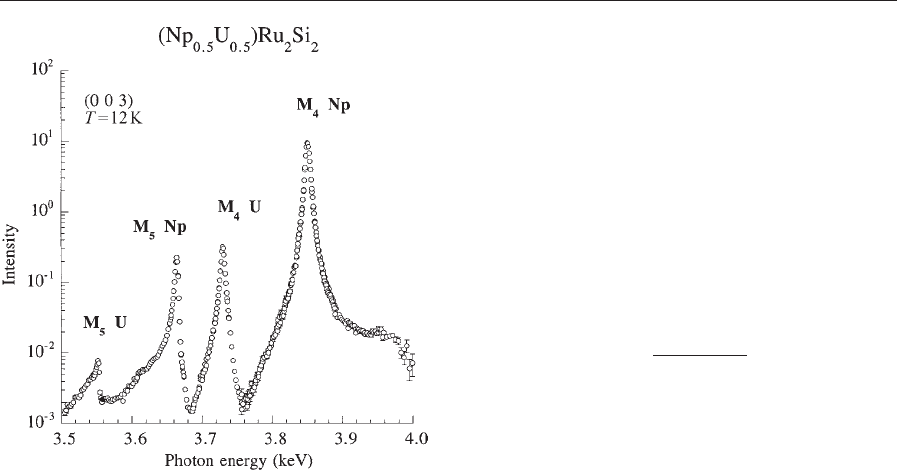
(Watson et al. 1996, MacKay et al. 1996). The rela-
tionship of the magnetic spatial profile and magnetic
roughness to the chemical or charge profile can then
be determined owing to these enhanced intensities.
The chemical selectivity of resonant x-ray scatter-
ing is demonstrated in Fig. 3 which shows the
incident photon energy dependence of an antiferro-
magnetic Bragg peak from a mixed compound,
U
0.5
Np
0.5
Ru
2
Si
2
, containing two magnetic species,
uranium and neptunium. Tuning the photon energy
to a given edge (e.g., uranium M
4
edge), turns on the
signal from the uranium magnetization, while the
neptunium response is extinct (or at least several or-
ders of magnitude weaker). Conversely, data taken at
the neptunium M
4
edge probe the behavior of the
neptunium moments only. This selectivity of the
scattering species constitutes an advantage of x-ray
resonant techniques over nonresonant x-ray methods
and neutron techniques.
5. Spin Polarized Photon Absorption
The x-ray absorption cross-section is given by the
imaginary part of the scattering amplitude at Q ¼0
and resonant magnetic effects are also seen in ab-
sorption measurements. The observed effects are
related to the x-ray polarization. The absorption
coefficients vary when the easy direction of the mag-
netization is changed with respect to the incident
x-ray polarization or vice versa: this effect is called
magnetic linear dichroism. The absorption of circu-
larly polarized x rays depends also on the helicity of
the incident photons relative to the direction of the
magnetization: this is magnetic circular dichroism
(MCD). In all measurements, the magnetic contrast
in the absorption process is obtained by changing the
relative orientation of the polarization and the mag-
netization. The observed dichroic signal is taken as
the ratio
R ¼
mðLÞmðRÞ
mðLÞþmðRÞ
where L and R denote the two photon helicities,
and m is the fluorescent signal or the absorption
coefficient.
Similarly to the resonant scattering amplitude, the
MCD signal is simply proportional to the spin polar-
ized density of states of the intermediate states that are
excited during the transition (Schu
¨
tz et al.1987).
However, the orbital moment of the intermediate
states is also likely to play a significant role in deter-
mining transition probabilities, especially in the cases
of localized f-electron states. Indeed, a sum rule for the
integral of the dichroic signal (the imaginary part
of the magnetic scattering amplitude with y ¼0in
Eqn. (10b) over a given edge has been derived (Thole
et al. 1992) which allows a determination of the
ground state value of the orbital moment in the elec-
tronic available states. This sum rule, which is rigor-
ously valid only in the atomic case, has been extended
to single electron band models. Furthermore, other
sum rules have also been obtained involving expecta-
tion values of the spin operators (Carra et al. 1993).
Sum rules are derived for the absorption coeffi-
cient, related to f
00
¼Im{f
n
(k
f
¼k
i
, _o)}; equivalent
sum rules for the scattering case, where the total
scattering amplitude 7 f
n
7
2
is measured, would be
more difficult to extract. The dichroism methods can
bring new information on the ground state electronic
properties of magnetic systems. Compared to scat-
tering techniques, absorption methods have two con-
siderable advantages: (a) they can be performed
extremely rapidly (only the incident photon energy is
varied and nothing else changes); and (b) they do not
require single-crystal samples (any type of sample can
be studied). However, no information in Q-space is
obtained and MCD experiments can only probe
magnetized samples, such as ferromagnets and ferri-
magnets.
Dichroic effects are studied at low-energy absorp-
tion edges (L edges for 3d transition metals and M
edges of rare earths) by using fluorescence or electron
Figure 3
Demonstration of chemical selectivity. The intensity of
the antiferromagnetic intensity from Np
0.5
U
0.5
Ru
2
Si
2
is
measured as a function of photon energy around the
M
4,5
edges of uranium and neptunium. At the
neptunium M
4
edge the signal arising from the
magnetization on the neptunium sites is greater than the
uranium contributions by four or five orders of
magnitude.
746
Magnetism: Applications of Synchrotron Radiation
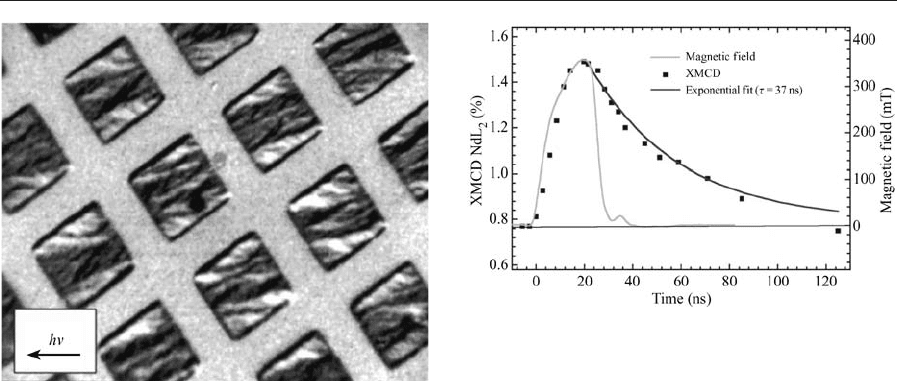
yield methods. At these energies, experiments are
sensitive to the surface state and to the magnetism at
surfaces. Local magnetic environments of magnetic
species are revealed by magnetic fluorescence spectra.
Because of the chemical selectivity, the various com-
ponents of magnetic alloys and compounds can be
studied independently. Even images of ferromagnetic
domains have been obtained, leading to technological
applications (Schu
¨
tz et al. 1997, Schneider et al.
1997). The combined use of MCD methods and x-ray
zone played microscopy can provide high-resolution
images of ferromagnetic domains with spatial reso-
lution of 50 nm and real time evolution. Figure 4
shows a magnetic domain pattern in a microstruc-
tured CoPt multiplayer. The pattern is obtained by
subtracting two images recorded at the cobalt L
3
edges with opposite radiation helicity. The resulting
contrast arises from the relative orientation of the
cobalt magnetization and light incidence. The white
(black) areas correspond to regions with magnetiza-
tion parallel (antiparallel) to the incident light as in-
dicated by the arrow. The magnetization is
perpendicular to the incident light in the gray areas.
A very promising application of MCD experiments
is the possibility of performing time-resolved studies.
The combination of the pulsed time structure of the
synchrotron x-ray beam and the fast acquisition rate
of MCD allows studies of magnetic dynamics of
ferromagnets. The use of energy-dispersive x-ray ab-
sorption enables fast dynamics to be studied (down to
nanoseconds) over a typical size of 20 mm. An exam-
ple is given in Fig. 5. The MCD signal has been
measured from a complex magnetic system consisting
of hard magnetic grains (Nd
2
Fe
14
B) embedded in a
soft matrix (spring magnet) at the L
2
edge of neo-
dymium. Owing to the selectivity of the MCD meth-
od, the neodymium hysteresis cycle can be observed
together with the relaxation response of neodymium
under the application of a pulse field (Fig. 5). The
determination of the relaxation time makes it possible
to analyze the different mechanisms driving the
coercivity. Other applications include the studies of
dynamics of recording or switching devices (Bonfim
et al. 1998). The uniqueness of the chemical selectivity
makes time-resolved MCD an ideal diagnostic probe
for the magnetic properties of multicomponent mag-
netic devices such a spin valves and spring magnets.
6. Future Directions
Synchrotron methods for the study of magnetism
have been in use since the early 1980s, and the most
remarkable achievements using resonant scattering
have been obtained since the early 1990s. New ap-
plications have appeared, some of which have arisen
owing to the progress in instrumentation and some
from a better understanding of the physics. Synchro-
tron sources and x-ray instruments are likely to im-
prove, yielding new prospects for more applications
(studies of microcrystals, coherent effects and mag-
netic speckles, magnetic inelastic x-ray scattering,
time-resolved studies). Theoretical approaches, which
have been stimulated by experimental results, will in
turn lead to more fundamental applications and
studies of the microscopic magnetic properties of
solids. Synchrotron x rays will offer new tools for
detailed studies of magnetism, which complement
neutron scattering techniques.
See also : Magnetic Excitations in Solids; Muon Spin
Rotation: Applications in Magnetism; Transparent
Rare Earth Compounds: Magnetic Circular Dichro-
ism; Thin Film Magnetism: PEEM Studies
Figure 4
Difference images of magnetic domains in a patterned
CoPt multilayer taken at the cobalt L
3
edge. Squares
have side length of 20 mm. The arrow indicates the
incidence direction of the circularly polarized x rays.
Figure 5
Time response of neodymium magnetization under the
application of a pulsed magnetic field of 300 mT.
747
Magnetism: Applications of Synchrotron Radiation

Bibliography
de Bergevin F, Brunel M 1972 Observation of magnetic super-
lattice peaks by x-ray diffraction of an antiferromagnetic
NiO crystal. Phys. Lett. 39A, 141–2
Blume M 1994 Magnetic effects in anomalous dispersion. In:
Materlik G, Sparks C J, Fischer K (eds.) Resonant Anoma-
lous X-ray Scattering. Elsevier, Amsterdam
Blume M, Gibbs D 1988 Polarization dependence of magnetic
x-ray scattering. Phys. Rev. B 37, 1779–89
Bonfim M, MacKay K, Pizzini S, San Miguel A, Tolentino H,
Giles C, Hagelstein M, Baudelet F, Malgrange C, Fontaine A
1998 Nanosecond-resolved XMCD on ID24 at the ESRF to
investigate the element-selective dynamics of magnetization
switching of Gd–Co amorphous thin film. J. Synchrotron
Rad. 5, 750–2
Cahn R W, Lifshin E 1993 Concise Encyclopedia of Materials
Characterization. Pergamon, Oxford
Carra P, Ko
¨
nig H, Thole B T, Altarelli M 1993 Magnetic x-ray
dichroism: general features of dipolar and quadrupolar spec-
tra. Physica B 192, 182
Fernandez V, Vettier C, de Bergevin F, Giles C, Neubeck W
1998 Observation of orbital momentum in NiO. Phys. Rev. B
57, 7870–6
Hannon J P, Tramell G T, Blume M, Gibbs D 1988 X-ray
resonance exchange scattering. Phys. Rev. Lett. 61, 1245–8
Kao C-C, Chen C T, Johnson E D, Hastings J B, Lin H I, Ho G
H, Meigs G, Brot J M, Hulbert S L, Idzerda Y U, Vettier C
1994 Dichroic interference effects in circularly polarized soft
x-ray resonant magnetic scattering. Phys. Rev. B 50, 9599–602
Lovesey S W, Collins S P 1996 X-Ray Scattering and Absorption
by Magnetic Materials. Oxford Science, New York
MacKay J F, Terchert C, Savage D E, Lagally M G 1996 El-
ement specific magnetization of buried interfaces by diffuse
x-ray resonant magnetic scattering. Phys. Rev. Lett. 77, 3925–8
Schneider C M, Fro
¨
mter R, Ziethen C, Swiech W, Brookes N
B, Scho
¨
nhense G, Kirschner J 1997 Magnetic domain imag-
ing with a photoemission microscope. Mater. Res. Soc.
Symp. Proc. 475, 381–92
Schu
¨
tz G, Fischer P, Attenkofer K, Ahlers D 1997 New ap-
plications of x-ray magnetic circular dichroism. In: Johnson
R L, Schmidt-Bo
¨
cking H, Sonntag B F (eds.) Proc. X-ray and
Inner-Shell Processes. AIP, Hamburg, Germany, pp. 512–33
Schu
¨
tz G, Wagner W, Wilhelm W, Kiemle P, Zeller R, Frahm
R, Materlik G 1987 Absorption of circularly polarized x rays
in iron. Phys. Rev. Lett. 58, 737–40
Squires G L 1978 Introduction to the Theory of Thermal Neutron
Scattering. Cambridge University Press, Cambridge
Templeton D H 1994 X-ray resonance, then and now. In:
Materlik G, Sparks C J, Fischer K (eds.) Resonant Anoma-
lous X-ray Scattering. Elsevier, Amsterdam
Thole B T, Carra P, Sette F, van der Laan G 1992 X-ray cir-
cular dichroism as a probe of orbital magnetization. Phys.
Rev. Lett. 68, 1943–6
Tonnerre J M, Seve L, Raoux D, Rodmacq B, Souille G, Wolfers
P 1995 Soft x-ray resonant magnetic scattering from a mag-
netically coupled Ag/Ni multilayer. Phys. Rev. Lett. 75,740–3
Watson G M, Gibbs D, Lander G H, Gaulin B D, Berman L E,
Matzke H J, Ellis W 1996 X-ray scattering study of the
magnetic structure near the (001) surface of UO
2
. Phys. Rev.
Lett. 77, 751–4
C. Vettier
European Synchrotron Radiation Facility
Grenoble, France
Magnetism: High-field
The effect of an applied magnetic field on matter de-
pends on whether the field is large enough to compete
with the magnetic interactions that are present within
the material. Only then can a modification of the
magnetic state can be induced. The related change in
magnetization should be large enough to be observed
with sufficient accuracy. High magnetic fields are
generated worldwide, in many laboratories and in
special user facilities. After a brief review of the tech-
niques that are applied to produce high magnetic
fields, this article focuses on a representative selection
of the large variety of phenomena that may be ob-
served in the magnetization of magnetic materials
when they are exposed to high magnetic fields. Also,
the information that can be deduced from the ob-
served high-field behavior will be briefly discussed.
In magnetic materials, the exchange interaction
between the magnetic moments generally is the most
prominent interaction. Depending on the solid, the
exchange interaction may be of different type, and, at
temperatures where the thermal energy is lower than
the strength of the exchange interaction, will give rise
to an ordered structure of the magnetic moments.
The strength of the exchange interaction may be ex-
pressed in terms of an internal ‘‘exchange field’’ that
acts on the magnetic moments and that may be as
high as 1000 T. Also, the magnetocrystalline aniso-
tropy in solids may be appreciable and, in specific
materials, may be equivalent to a few hundred teslas.
The examples discussed in this article have been
taken from the vast body of high-field research that
has been carried out on transition metals, rare-earth
metals, alloys, and intermetallic compounds. For
other specific subjects and other categories of mate-
rials in which the response to high magnetic fields
may play a significant role, for instance low-dimen-
sional spin systems, critical phenomena, low-dimen-
sional semiconductor structures, heavy-fermion
systems, and superconductors, the reader is referred
to the articles devoted to these subjects and materials.
1. Production of High Magnetic Fields
Static magnetic fields can be generated by transmit-
ting electrical current through resistive coils that have
to be water-cooled in order to remove the dissipated
heat or by transmitting current through supercon-
ducting coils. In resistive coils, the largest fields made
in this way are in the range 30–35 T, whereas in su-
perconducting coils made of conventional supercon-
ductors, the maximum field is around 23 T. Larger
static magnetic fields (up to 40–45 T) can be gener-
ated in hybrid magnets, in which superconducting
coils are placed around a water-cooled resistive-coil
system, in this way providing a supporting back-
ground field of the order of 10 T.
748
Magnetism: High-field
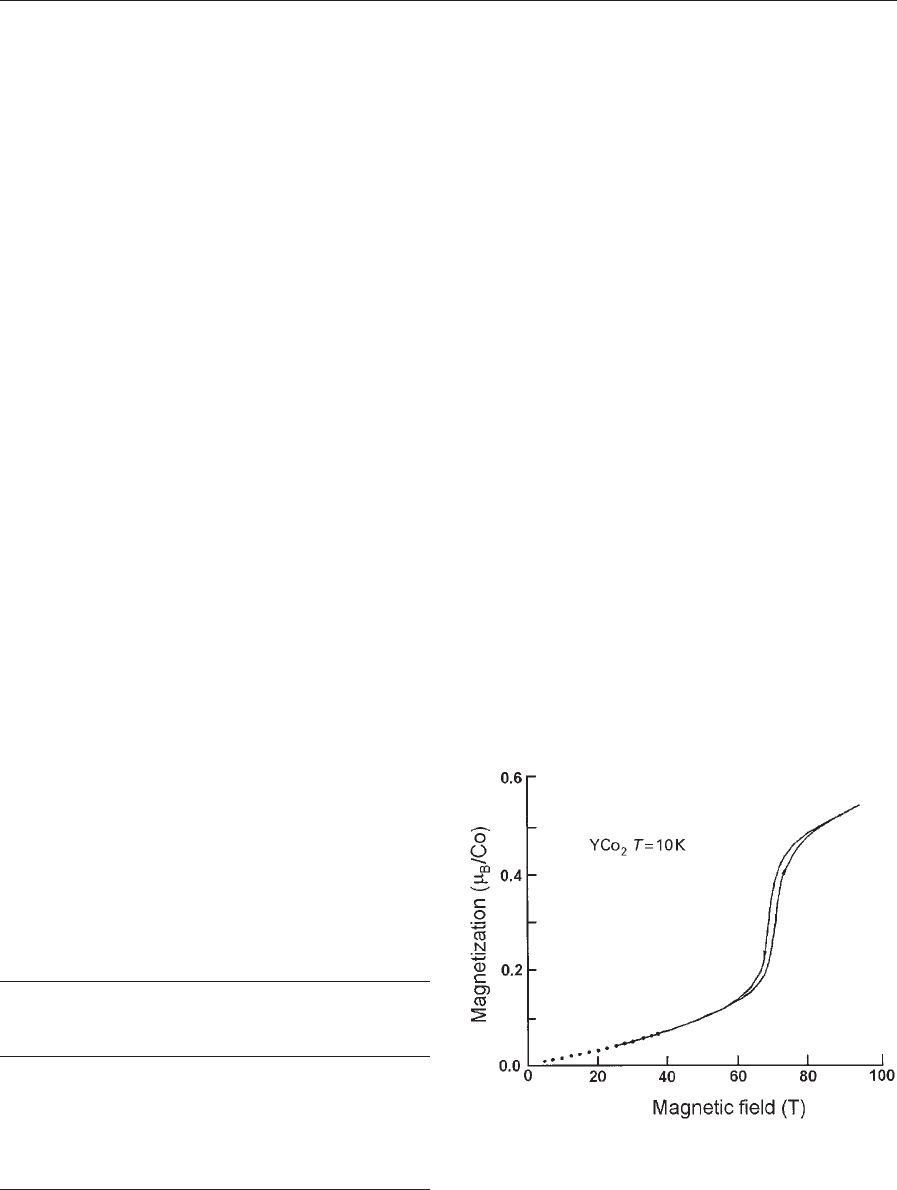
In resistive-coil systems, the value of the highest
possible field is mainly determined by the available
electrical power and by the limited cooling capacity.
In the case of superconducting coils, the main lim-
iting factor is the field at which the coil material
looses its superconducting properties and becomes
normal. Coils made of high T
c
superconductors may
lead to significant progress. However, for this to be
possible, a number of important technological prob-
lems, for instance the production of wire of adequate
mechanical strength, have to be solved.
The range of possible fields is appreciably larger if
pulsed fields are considered. In pulsed magnets, the
coils are energized only for a short time during which
the dissipated heat cannot be removed by the cooling
water and is mainly absorbed by the coil, which
therefore increases in temperature during the pulse.
For pulsed fields, the coils are usually energized by
capacitor banks or flywheel generators. In practice,
two time regimes are distinguished for the duration of
the field pulse:
long pulses with a duration of the order of 10 ms
to 1 s that produce fields in the range 60–80 T; and
short pulses with a duration in the microsecond
region that produce fields in the range 100–500 T.
In general, short-pulse experiments are more dif-
ficult than long-pulse experiments and, as a conse-
quence, less accurate. Also, in a metallic material, a
pulsed magnetic field induces a current that is pro-
portional to the change of the field with time. There-
fore, experiments on this important category of solids
should be performed in static fields, in fields that are
kept constant for a sufficiently long time, or in long-
pulse fields that vary only slowly with time. The
magnetization measurements presented in this article
have been performed in long-pulse fields. Some ex-
amples of facilities where long-pulse fields are gener-
ated are given in Table 1.
2. 3d Magnetism
In 3d metal-based metallic substances with itinerant
electrons, the magnetism arises from electrons that
occupy allowed states in incompletely filled electron
bands that are filled up to the Fermi energy and that
can be subdivided into two subbands with opposite
spin directions that are equally occupied in the par-
amagnetic state. In a ferromagnet, and if a magnetic
field is applied also in a paramagnetic metal, the two
subbands are unequally occupied, thus giving rise to
a magnetic moment (see Itinerant Electron Systems:
Magnetism (Ferromagnetism)). Besides the exchange,
the density of electron states at the Fermi level and its
energy dependence determine the magnetic response
of a metal to an applied magnetic field. In exchange-
enhanced (Pauli) paramagnetic substances with a
peculiar band structure near the Fermi energy, an
applied magnetic field may induce a first-order phase
transition from the paramagnetic to the ferromag-
netic state. Transitions of this type, from a state with
a relatively small magnetic moment to one with a
larger moment, are generally denoted as metamag-
netic transitions and occur, as discussed below, in
many different types of magnetic materials. YCo
2
(Fig. 1) is an example of a nearly ferromagnetic com-
pound that undergoes such a transition at low tem-
peratures at a critical field as high as 69 T,
(see Metamagnetism: Itinerant Electrons).
3. 4f Magnetism
The rare-earth (R) metals with their partially filled 4f
shell and R-based compounds exhibit a large diver-
sity of magnetic structures which result from the
competition of the exchange interaction, the crystal-
line electric field (CEF) interaction, and the quadru-
polar interaction, the latter in general being much
smaller than the former two (see Localized 4f and 5f
Table 1
Examples of long-pulse facilities.
Location
Maximum field
in length
(T in mm)
Pulse length
(ms)
KU Leuven 60 in 20; 73 in 10 20; 10
NHMFL Los
Alamos
68 in 15; 60 in 32 20; 100
LNCMP
Toulouse
61 in 14 200
NRIM Tsukuba 65 in 16 100
Figure 1
Magnetization of YCo
2
at 10 K (after Duc and
Brommer 1999).
749
Magnetism: High-field
